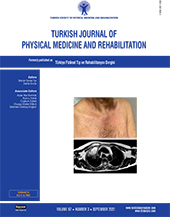Effects of a combination of scapular stabilization and thoracic extension exercises for office workers with forward head posture on the craniovertebral angle, respiration, pain, and disability: A randomized-controlled trial
Patients and methods: Between March 2018 and June 2018, a total of 32 office workers with FHP (13 males, 19 females; mean age 36.63 years; range, 23 to 57 years) were randomized either to experimental (n=16) or control groups (n=16). Scapular stabilization and thoracic extension exercises were applied to the experimental group and cervical stabilization and stretching exercises to the control group. The results of the pre-intervention and after six weeks measurement of the craniovertebral angle (CVA), respiration, pain, and disability were compared and analyzed.
Results: For intra-group comparison, both groups showed significant differences (p<0.05) in CVA, forced expiratory volume at 1 sec (FEV1), Visual Analog Scale (VAS), and neck disability index at pre- and post-intervention, while only the experimental group showed a significant difference (p<0.05) in maximum inspiratory pressure, maximum expiratory pressure, and forced vital capacity. For inter-group comparison, a significant difference (p<0.05) between FEV1 and VAS was observed.
Conclusion: The combination of scapular stabilization and thoracic extension exercises, not directly applied to the cervical spine, has an effect on improving the posture, respiration, neck pain, and disability in office workers with FHP.
Keywords : Cervical spine, exercise, head posture, neck pain

















